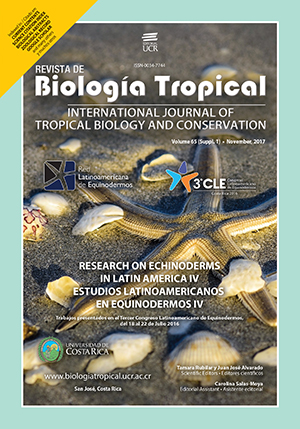Abstract
The sea urchins Arbacia incisa and Eucidaris thouarsii (Echinodermata) as fouling biocontrol agents in culture cages of Crassostrea gigas (Mollusca: Ostreidae).
Fouling clogs cultivation cages of bivalves afecting their growth. We tested biocontrol with sea urchins in the suspended culture of C. gigas during one month. The experimental design included: 1) oysters without sea urchins, 2) oysters with the black sea urchin Arbacia incisa (50.5 ± 0.43 mm of diameter testa-DT), 3) oysters with the pencil sea urchin E. thouarsii (34. 2 ± 2.13 mm DT) and 4) oysters without sea urchins with a pearl net protective bag (to avoid predation). The dry mass of the pearl nets and the oyster soft tissues were determined at the beginning and end of the experiment. There was similar fouling in cages without urchins (55.3 ± 5.80 g) and with A. incisa (46.1 ± 2.84 g). These amounts were significantly higher than those found in cages with E. thouarsii (39.1 ± 1.9 g) and with protective sacs without urchins (35.6 ± 5.17 g). The growth of C. gigas with E. thouarsii was significantly higher (0.49 ± 0.089 g). We recommend E. thouarsii as a fouling biocontrol agent for C. gigas. Rev. Biol. Trop. 65(Suppl. 1): S35-S41. Epub 2017 November 01.
References
Alcivar, G. (2015). Caracterización de la macrofauna marina perjudicial, adherida en sistemas de cultivo suspendido de Crassostrea gigas, en la ensenada de Palmar, Península de Santa Elena, enero-mayo, 2015. (Tesis de Licenciatura). Universidad Estatal Península de Santa Elena, Facultad de Ciencias del Mar. pp. 134.
Cigarría, J., Fernández, J., & Magadán, L. P. (1998). Feasibility of biological control of algal fouling in intertidal oyster culture using periwinkles. Journal of Shellfish Research, 17, 1167-1169.
Claereboudt, M., Bureau, D., Côté, J., & Himmelman, J. H. (1994). Fouling development and its effect on the growth of juvenile giant scallops (Placopecten magellanicus) in suspended culture. Aquaculture, 121, 327-342.
Cortés-Useche, C., Gómez-León, J., & Santos-Acevedo, M. (2011). Erizos de mar como control biológico del “fouling” en un cultivo de Nodipecten nodosus en el área de Santa Marta, Caribe colombiano. Boletín de Investigaciones Marinas y Costeras, 40(2),233-247.
De Sa, F. S., Nalesso, R.C., & Paresque K. (2007). Fouling organisms on Perna perna mussels: is it worth removing them? Brazilian Journal of Oceanography, 55, 155-161.
Dumont, C. P., Urriago, J. D., Abarca, A., Gaymer, C. F., & Thiel, M. (2009). The native rock shrimp Rhynchocinetes typus as a biological control of fouling in suspended scallop cultures. Aquaculture, 292, 74-79.
Enright, C., Krailo, D., Staples, L., Smiht, M., Vaughan, C., Ward, D., Gaul, P., & Borgese, E. (1984). Biological control of fouling algae in oyster aquacultureJournal of Shellfish Research, 3, 41-44.
Fitridge, I., Dempster T., Guenther J., & De Nys R. (2012). The impact and control of biofouling in marine Aquaculture: a review. Biofouling, 28: 649–669.
Hidu, H., Conary, C., & Chapman, S. R. (1981). Suspended culture of oysters: biological control. Aquaculture, 22, 189-192.
Lacoste, E., & Gaertner-Mazouni, N. (2014). Biofouling impact on production and ecosystem functioning: a review for bivalve aquaculture. Reviews in Aquaculture, 6, 1-10.
Lodeiros, C., & Garcia N. (2004). The use of sea urchins to control fouling during suspended culture of bivalves. Aquaculture, 231, 293-298.
Lodeiros, C., & Himmelman, J. H. (1996). Influence of fouling on the growth and survival of the tropical scallop, Euvola (Pecten ) ziczac (L. 1758) in suspended culture. Aquaculture, Res. 27, 749-756.
Lodeiros, C., & Himmelman, J. H. (2000). Identification of environmental factors affecting growth and survival of the tropical scallop Euvola (Pecten) ziczac in suspended culture in the Golfo de Cariaco, Venezuela. Aquaculture, 182, 91-114.
Lodeiros, C., Rodríguez-Pesantes, D., Márquez, A., Revilla, J., & Sonnenholzner, S. 2017. Cultivo suspendido de la ostra Crasssotrea gigas en la Bahía de Ayangue, Ecuador. Foro Ac. Rec. Mar. Rías Gal. XIX. 19: 317-330.
Lodeiros, C., Rengel, J., Freites, L., Morales, F., & Himmelman, J. H. (1998). Comparison of growth and survival of the tropical scallop Nodipecten (Lyropecten) nodosus maintained at three depths in suspended culture. Aquaculture, 165, 41-50.
Lombeida, P. (1997). Manual para el Cultivo de Ostras en Granjas Camaroneras. Proyecto JICA-CENAIM. 25 pp.
Malavé, C., Freites, L., Lodeiros, C., Mendoza, J., Troccoli L., & Dale A. (2012). Annual recruitment, predation rates and biocontrol of Linatella caudata (Mollusca: Gastropoda) in suspended enclosure culture of the pearl oyster Pinctada imbricata. Aquaculture, 354-355, 75-83.
Ross, K., Thorpe, J. & Brand, A. (2004). Biological control of fouling in suspended scallop cultivation. Aquaculture, 229, 99-116.
Uribe, E., Lodeiros, C., Felix-Pico E. & Etcherepare I. (2001). Epibiontes en pectínidos de Iberoamérica. In: A.N. Maeda-Martínez (ed.), Los Moluscos Pectínidos de Iberoamérica: Ciencia y Acuicultura. Cap. 13: 249-266.
Zar, J. H., (2010). Biostatistical analysis, 5th edition. Pentice Hall, Englewoods Cliff, N.J. 944 pp.
Zhanhui, Q., Jun, W., Yuze, M., Jihong, Z., Zengjie, J., & Jianguan F. (2014). Use of the sea urchin Hemicentrotus pulcherrimus for biological control of fouling in suspended scallop cultivation in Northern China. Aquaculture, 420, 270-274.
##plugins.facebook.comentarios##

This work is licensed under a Creative Commons Attribution 4.0 International License.
Copyright (c) 2017 Revista de Biología Tropical


